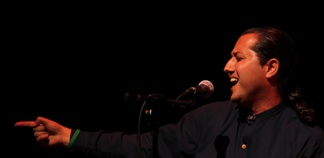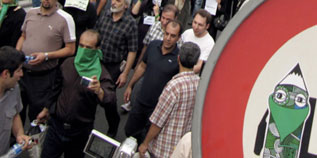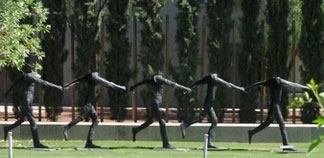به زبان فارسی
PICTORY
LATEST MUSIC
SEARCH
GUITAR
12-Sep-2009 (9 comments)
Try mentioning your Iranian background in a circle of cultured American friends. Instead of the usual questions about politics they may ask, “Do you know of Lily Afshar?” This is because Afshar is one of the world’s leading classical guitarists, with remarkable innovations furthering the influence of the instrument. In fact, someone once asked Afshar herself where she was from. That “someone” was Maestro Andres Segovia, the terrifyingly eminent virtuoso authority on the classical guitar. A group of 12 young guitarists had been selected out of hundreds of international competitors vying for the honor of playing in front of the guitar legend, hoping for an approving nod>>>
TREASURE
10-Sep-2009 (3 comments)
It had been many years since I had seen my Uncle Homayoun, with the difference that this time Auntie Shahin was gone. Tragically, his wife of 50+ years had died in a car crash. So when I opened the door to greet him, he simply fell into my arms and wept. This was a different man – someone who was far quicker to show his vulnerabilities, but even stronger than before because he didn’t waste time controlling impressions. Spending time with Dai Homayoun was nothing short of a pilgrimage for me. So many stories to share, so many new ways to look at everything>>>
GENIUS
04-Sep-2009 (4 comments)
Sadeq Hedayat was born on 17 February 1903 and died on 9 April 1951. He was descended from Rezaqoli Khan Hedayat, a notable 19th century poet, historian, and historian of Persian literature, and author of Majm‘ al-Fosaha, Riyaz al-‘Arefin and Rawza al-Safa-e Naseri. Many members of his extended family were important state officials, political leaders and army generals, both in the nineteenth and twentieth centuries, including Mokhber al-Dawleh, Nayyer al-Molk I (Hedayat’s grand-father), Sani‘ al-Dawleh, and Mokhber al-Saltaneh, who was prime minister between 1928 and 1933>>>
GHOST
02-Sep-2009 (2 comments)
My ominous association with ghosts goes back to my early childhood years. Aunt Sedighe my father’s youngest sister lived in Shoushtar, one of the oldest cities in the world, dating back to Achaemenian dynasty (400 BC). Shoushtar used to be the winter capital of Sassanian dynasty and it was built by the Karoun River. The river was channeled to form a trench around the city. A subterranean system called ghanats connected the river to the private reservoirs of houses and buildings, supplied water during times of war when the main gates were closed. The ruins of these ghanats still exist and one was connected to Aunt Sedighe’s house where my cousins and I explored if we dared to>>>
FILM
22-Aug-2009 (2 comments)
Reflecting on cities is as old as civilization itself. It all started with mythmaking 78 centuries ago as Sumerians speculated about the origins of Ur, Uruk, Kish and Lagash. They believed that their cities were built by Gods. One would think that if anyone knew who built those ziggurats and magnificent walls, they did. Archaic Greeks too insisted that the massive boulders of Mycenae were moved by the giant Cyclops. Masud Bakhshi also starts his tribute to Tehran with the myth that it was founded by a bandit tribe that lived underground and grew excellent pomegranates>>>
LETTER
20-Aug-2009 (5 comments)
Mr. Obama, what has happened to the human rights that America has always stood for? Thousands upon thousands of Iranians residing in this country voted for you with the impression that you are a champion of human rights, freedom, and just causes because you yourself have had first-hand experience in discrimination and suppression. Just a few weeks ago you declared Islamic Republics a danger to the world. You are an ardent advocate against terrorism yet clandestine terrorism against the freedom movement in Iran is in full force by the regime and totally ignored by you>>>
CONFESSIONS
09-Aug-2009 (8 comments)
در ایران معاصر اعتراف گیری تاریخچه ای دیرپا دارد و در رژیم سابق و فعلی به وفور مورد استفاده قرار گرفته است. پرویز نیکخواه، کورش لاشائی، رضا براهنی، غلامحسین ساعدی، و پرویز قلیچ حانی از معروفترین قربانیان پروژهء اعتراف گیری در رژیم پهلوی به شمارمیروند. پرویز نیکخواه در دادگاه به عنوان یکی از عوامل طرح ترور محمدرضا شاه در سال ۱۳۴۴ به ده سال زندان محکوم شد و مدت شش سال در مقابل فشارهای ساواک ایستادگی کرد ولی به یکباره مقاومتش در هم شکست و در ششمین سال زندان به جرم خود اعتراف کرده و شروع به همکاری با رژیم شاه کرد. پس از آن بود که از کسوت یک قهرمان خارج شده و حتی بین همفکرانش در گروه های چپ نیز به عنصری منفور و خائن بدل گشت>>>
LITERATURE
05-Aug-2009 (one comment)
“Stray Dog” is one of Hedayat’s best psycho-fictions and one of the most moving pieces he ever wrote. It is tempting to say that it is a fictionalised version of his youthful essay, “Man and Animal”. Its text and outer layer certainly represent an authentic and unmistakable fiction by the author of that essay and its sequel, The Benefits of Vegetarianism.2 It is true that Hedayat never ceased to condemn cruelty and injustice to animals in every possible way: both by word of mouth and by the pen.3 In his fictional works, these sentiments find strong expression especially in “Stray Dog” and in “Alaviyeh Khanom”, here in the scene when the coach horses fall down>>>
FASSIH
29-Jul-2009 (5 comments)
دوران دوران آپولو 11 بود و مسابقات بوکس محمد علی کلی روی صفحه سیاه و سفید تلویزیون مبله بلر. دوران رفتن به هنرستان شرکت نفت و عشق کارمند شدن و رویاهای دور و دراز نوجوانی. فصل راز و نیاز از راه دور با سوفیالورن بود و حسرت خوردن به مارچلو ماسترویانی و آلن دلون روی پرده سینما کارون اهواز. سالهای خرید قسطی «پیکان جوانان» و کشیدن سیگار وینستون پشت دو لیوان آبجوی مجیدیه. دورانی که اعلیحضرت هنوز دست توی جیب های جلیقه اش نکرده بود و لوله های نفت از گناوه به دل دریا فرو میرفت و از جزیره خارگ سر درمیآورد و نفتکشها، ایران را جزیره آرامش می دیدند. به عقل جن هم نمی رسید که عاقبت «دندانه هر قصری پندی دهدت نو نو». توی همین سالها بود که با اسماعیل فصیح آشنا شدم. مردی که سالهای بعد رمان نویس معروفی شد>>>
RECENT COMMENTS
IRANIANS OF THE DAY
| Person | About | Day |
|---|---|---|
| نسرین ستوده: زندانی روز | Dec 04 | |
| Saeed Malekpour: Prisoner of the day | Lawyer says death sentence suspended | Dec 03 |
| Majid Tavakoli: Prisoner of the day | Iterview with mother | Dec 02 |
| احسان نراقی: جامعه شناس و نویسنده ۱۳۰۵-۱۳۹۱ | Dec 02 | |
| Nasrin Sotoudeh: Prisoner of the day | 46 days on hunger strike | Dec 01 |
| Nasrin Sotoudeh: Graffiti | In Barcelona | Nov 30 |
| گوهر عشقی: مادر ستار بهشتی | Nov 30 | |
| Abdollah Momeni: Prisoner of the day | Activist denied leave and family visits for 1.5 years | Nov 30 |
| محمد کلالی: یکی از حمله کنندگان به سفارت ایران در برلین | Nov 29 | |
| Habibollah Golparipour: Prisoner of the day | Kurdish Activist on Death Row | Nov 28 |
















